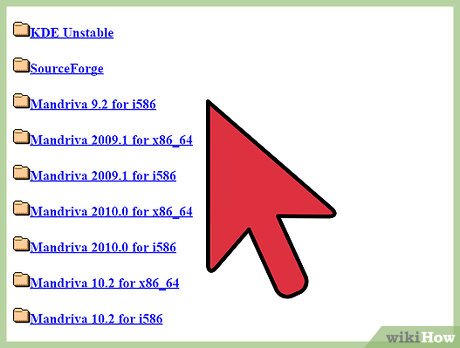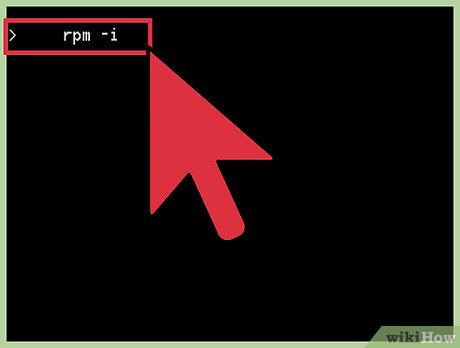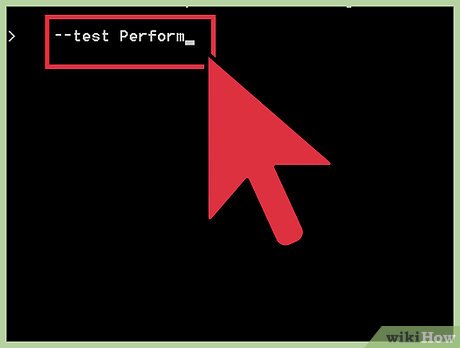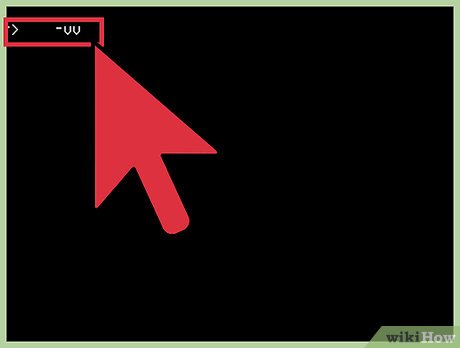How to Install or Remove an RPM Package
Method 1 of 3:
Installation
-
 Download your desired RPM package. There are many RPM depositories on the Internet, but if you're looking for Red Hat RPM packages, you can find them here:
Download your desired RPM package. There are many RPM depositories on the Internet, but if you're looking for Red Hat RPM packages, you can find them here:- The Red Hat Enterprise Linux installation media, which contain many installable RPMs.
- The initial RPM repositories provided with the YUM package manager.
- The Extra Packages for Enterprise Linux (EPEL) provides high-quality add-on packages for Red Hat Enterprise Linux.
-
 Install the RPM package. Once downloaded, you have two options:
Install the RPM package. Once downloaded, you have two options:- Double-click the package. A package management window will appear with instructions to guide you through the process.
- Open a terminal window, and type
rpm -i *package_location_and_name*(without the spaces inand)
Method 2 of 3:
Removal
-
 Open a terminal window, and type:
Open a terminal window, and type:rpm -e *package_name*. Do not type the extension on the file. For example:rpm -e gedit
Method 3 of 3:
rpm codes
-
 The rpm -i command syntax is listed below.
The rpm -i command syntax is listed below. -
 Install-specific options:
Install-specific options:- -h (or --hash) Print hash marks ("#") during install
- --test Perform installation tests only
- --percent Print percentages during install
- --excludedocs Do not install documentation
- --includedocs Install documentation
- --replacepkgs Replace a package with a new copy of itself
- --replacefiles Replace files owned by another package
- --force Ignore package and file conflicts
- --noscripts Do not execute pre- and post-install scripts
- --prefix Relocate package to if possible
- --ignorearch Do not verify package architecture
- --ignoreos Do not verify package operating system
- --nodeps Do not check dependencies
- --ftpproxy Use as the FTP proxy
- --ftpport Use as the FTP port
-
 General Options
General Options- -v Display additional information
- -vv Display debugging information
- --root Set alternate root to
- --rcfile Set alternate rpmrc file to
- --dbpath Use to find the RPM database
5 ★ | 1 Vote
You should read it
- How to install Pip in Ubuntu
- How to use winget - New Package Manager for Windows 10
- What is a package dependency in Linux?
- How to install Skye on Ubuntu
- Binary and Source Package: Which should be used?
- How to find out if the package is installed in Linux
- How to Install DEB Files
- Instructions for registering V90 package is only 90k to receive the super 3-in-1 integration right away
May be interested
- Instructions for registering V90 package is only 90k to receive the super 3-in-1 integration right away
 v90 viettel package has just been officially launched, creating a hot fever for all subscribers who are using the service of the network because of too great incentives to have any promotion packages that match at the present time.
v90 viettel package has just been officially launched, creating a hot fever for all subscribers who are using the service of the network because of too great incentives to have any promotion packages that match at the present time. - Install and configure Apache in Ubuntu
 in the following article, we will show you some basic steps to install and set up a web server system using apache on the ubuntu platform. in fact, this step is quite simple and easy, just use synaptic package manager, ubuntu software center to search and install apache2 module package.
in the following article, we will show you some basic steps to install and set up a web server system using apache on the ubuntu platform. in fact, this step is quite simple and easy, just use synaptic package manager, ubuntu software center to search and install apache2 module package. - Package in Python
 we will learn how to divide code into efficient, clear modules, using python packages. plus, the way to import and use your own package, or the package you download from somewhere into the python program.
we will learn how to divide code into efficient, clear modules, using python packages. plus, the way to import and use your own package, or the package you download from somewhere into the python program. - Winstall.app - web-based GUI for Windows Package Manager only
 winstall.app is a web application that acts as a gui version of windows package manager, helping users find and install applications more easily on an individual basis.
winstall.app is a web application that acts as a gui version of windows package manager, helping users find and install applications more easily on an individual basis. - How to check Internet package network FPT, VNPT, Viettel are using
 regularly checking internet network packages fpt, vnpt, viettel are using the following ways to make it easier for you to monitor internet connection speed, and if you encounter any problems, you can contact immediately network operators to ensure that the line is always stable, without affecting your work or leisure time.
regularly checking internet network packages fpt, vnpt, viettel are using the following ways to make it easier for you to monitor internet connection speed, and if you encounter any problems, you can contact immediately network operators to ensure that the line is always stable, without affecting your work or leisure time. - Basic instructions on how to properly remove and install a CPU cooling fan
 the cooling fan helps keep the cpu temperature stable. let's learn how to remove and install the cpu cooling fan most effectively.
the cooling fan helps keep the cpu temperature stable. let's learn how to remove and install the cpu cooling fan most effectively. - Install Python Package with PIP on Windows, Mac and Linux
 like many other programming languages, python supports extremely useful third-party libraries and frameworks that you can use to avoid losing your rewrite from scratch.
like many other programming languages, python supports extremely useful third-party libraries and frameworks that you can use to avoid losing your rewrite from scratch. - Add-ins in Excel: How to install and remove
 the features in excel are many but not enough, with complex functions or features in excel without you, you can install add-ins to manipulate and process data more easily. when not needed, you can remove add-in from excel.
the features in excel are many but not enough, with complex functions or features in excel without you, you can install add-ins to manipulate and process data more easily. when not needed, you can remove add-in from excel. - How to remove and use the juicer simply
 if you don't know how to remove the juicer and how to use it effectively, don't miss this article. surely you will be confident to be able to make attractive drinks for the whole family!
if you don't know how to remove the juicer and how to use it effectively, don't miss this article. surely you will be confident to be able to make attractive drinks for the whole family! - Exciting with World Cup MobiFone launched a great data package
 to help users do not miss any match, mobifone recently launched a super-heavy package to meet the demand of watching football of fans nationwide.
to help users do not miss any match, mobifone recently launched a super-heavy package to meet the demand of watching football of fans nationwide.
















 How to Download Miniclip Games
How to Download Miniclip Games How to Update Your iPhone
How to Update Your iPhone How to Install Qt SDK on Ubuntu Linux
How to Install Qt SDK on Ubuntu Linux How to Install a Sony Walkman MP3 Player
How to Install a Sony Walkman MP3 Player How to Uninstall Eset Smart Security 5
How to Uninstall Eset Smart Security 5 How to Install WhatsApp on PC or Mac
How to Install WhatsApp on PC or Mac